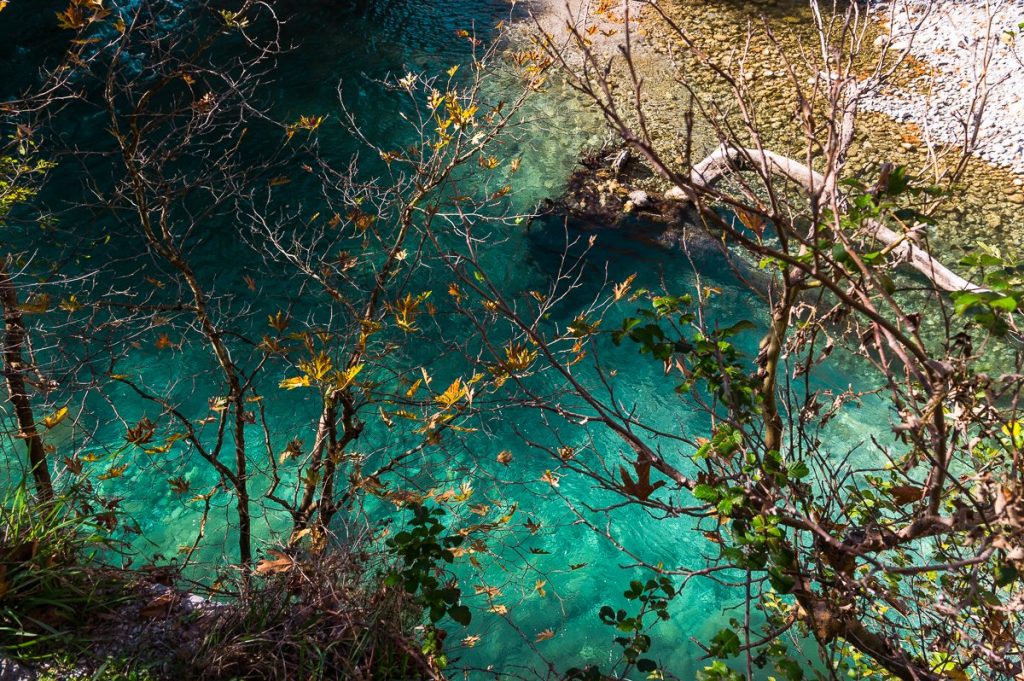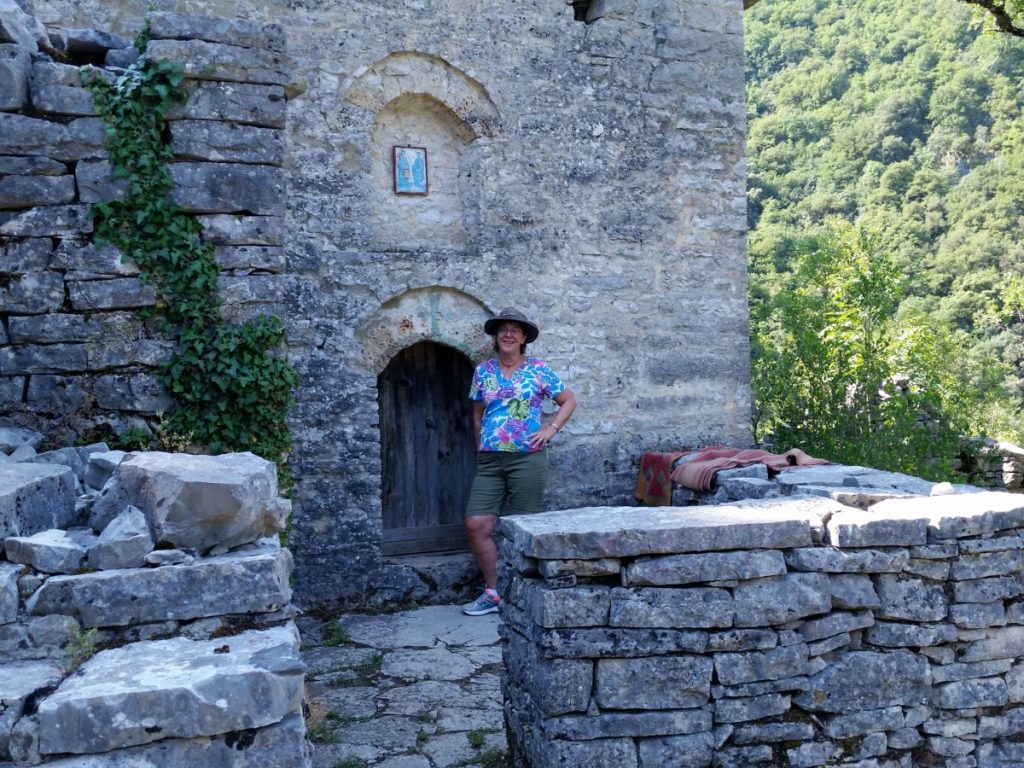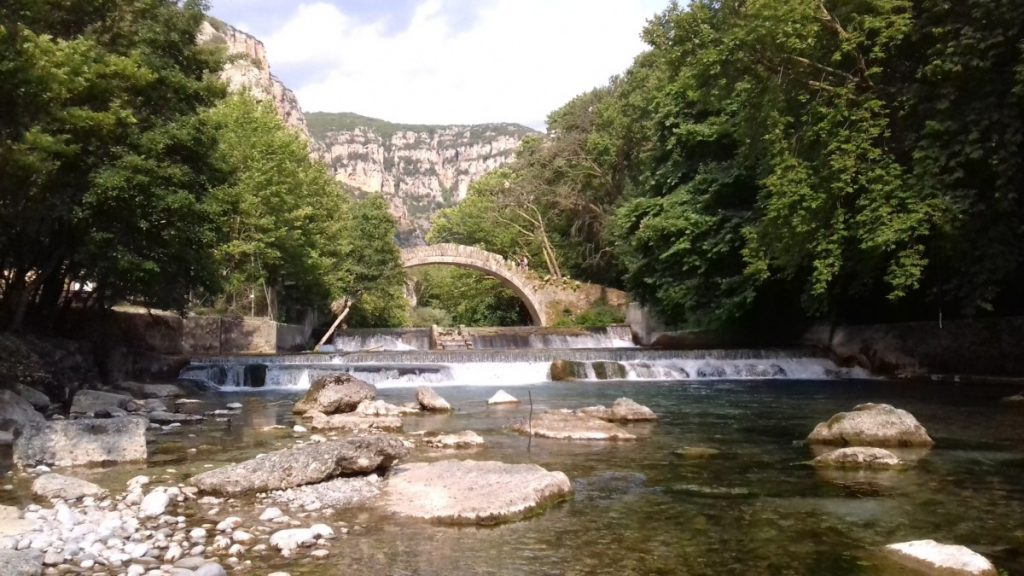Today was a big outdoor day for us. We drove to the trail head to hike along the Voidomatis River starting at Aristi Bridge and ending up at the infamous Kleidoni Bridge. It’s an easy hike that follows the river winding in and out of huge trees and passing by a monastery. We didn’t see many other people hiking and just one group of rafters.
The river flows through the Vikos gorge. Its water is clear, blueish green and drinkable and is supposed to be the cleanest river in Europe. The area is protected and only rafting is permitted in the water – no fishing is allowed or motorized boating.


We visited one small abandoned monastery perched on a rock near the river’s banks. Greece is full of abandoned churches and monasteries built centuries ago. Yet their doors remain open, candles are burning and icons are intact on the walls and in the altars.

The morning started out at a nice walking temperature of 19 degrees. We didn’t walk all the way to the Kleidoni bridge because it was starting to get quite warm by noon. At one point I thought my feet needed some refreshments so I dipped them in the cold waters and decided it was a little too cold for me to go swimming.
After our hike, we drove another 30 km to hunt for an ATM machine and a gas station to fill up for the next day’s drive. Megalo Papinko had no facilities other than places to sleep and restaurants. One gift shop was open but there was no grocery store, ATM, or any other retail establishments.
After lunch and a nap, the guides from Papingko Rafting picked us up in their van for our afternoon adventure. We were signed up for a 2 hour rafting trip down the Voidomatis River, actually following the same path we had hiked that morning. It was quite fun to see the gorge from the river. On the water I had a better perspective of the beautiful vegetation and the height of the gorge walls. We wore wet suits and helmets and were ready for action. Our fellow rafters were an Israeli family of three who we had met in Mikro Papingko the day before.

We did get to see the famous Kleidoni Bridge at the end of our paddle. This bridge is famous for a crime that happened in the 16th century, and the bloody vendetta that followed after, deserting a village of 700 people.

There were two wealthy families (Gerenis and Stamatis) in the village of Agios Minas. There became a rivalry between the two families – though now noone knows the reason. On Gereni’s daughter’s wedding day, Stamatis set an ambush with some of his relatives and the moment the bridal march was on the bridge, they opened fire. Gerenis with his wife and two of his nephews dropped dead. This incident ignited an unprecedented vendetta which lasted for years and eventually forced the residents to abandon the village since not even the authorities (Ottoman empire) could bring back order.
Our visit was uneventful! We tried our fourth restaurant in Megalo P and it was quite a hit. Our guide was there with his family as were the other paddlers. As I said, it’s a very small village with not very many visitors.
The Zagora area is known for its bridges, many dating back hundreds of years. They were built as pack horse bridges to get across the many streams and rivers. Some are passable by car – one lane only and some are for pedestrians only.
About the Region
The houses are hidden behind heavy wood doors and thick stone walls. Every home has a garden behind the walls. The homes are built from slabs of stone quarried from the area’s mountains. Many of the guest rooms for rent are located in renovated mansions called archontiki. They all have small windows with bars and sturdy old heavy entrance doors with big iron locking systems. There are no balconies but the rooms have high ceilings, wood floors and not much light. The streets are cobblestone throughout.
There are 46 villages in Zagaorahoria. They were able to exist and thrive during Ali Pasha’s reign at the end of the Ottoman Empire by working a deal and paying taxes, only if the Turks stayed away. Wealth in the villages was earned by emigrants who would send money while working abroad in Europe, US and Australia, then retiring back in their village. Now Albanian immigrants do much of the renovation and construction work on these old village structures.
The Sarakastani nomads also lived in this area. Patrick Fermour writes about them in his book on Northern Greece, Roumeli. Many of them had to settle in a village after the Greek/Turkish population exchange in 1922/23. Shepherding is still a way of life in the mountains but is disappearing. We saw many shepherds with their flocks on the roads – some on foot and some on motorbikes or in trucks.
Winter is a popular time to visit this area for the Greeks. It’s a good time to hike when it’s cold.
Zagora is just one section of the Pindos Mountains in the greater region of Epirus, located in Northwestern Greece next to the Albanian border. The area is popular for hikers with trails up the mountains, through the gorge and between the villages.
